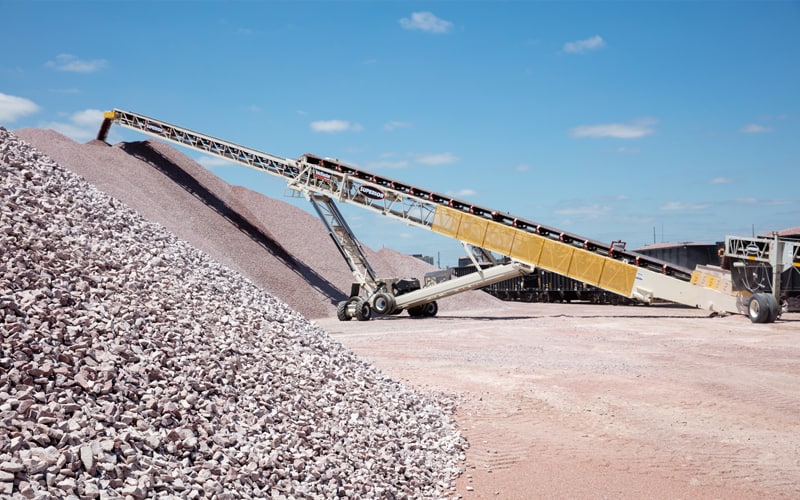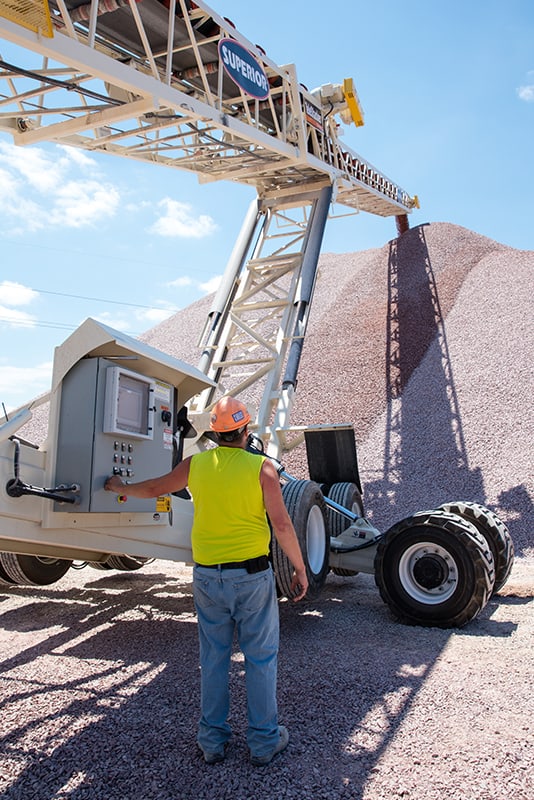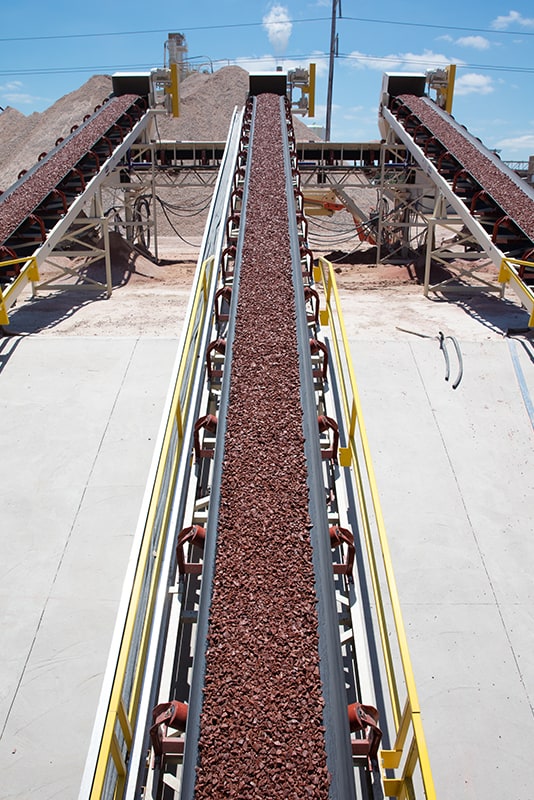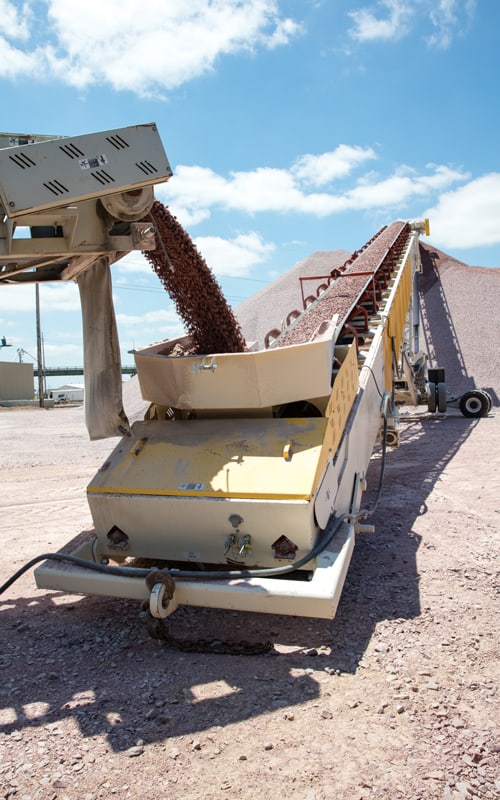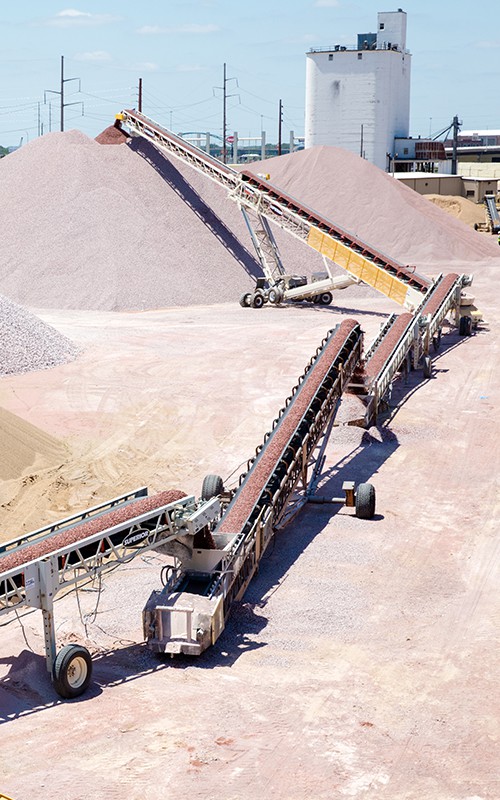From Train to Truck
An Iowa-Based Aggregate Transloading Facility Boosts Productivity with New Unloading System
Transloading is defined as transferring a shipment from one mode of transportation to another. At the L.G. Everist transloading facility in Sioux City, Iowa, high-quality aggregate is unloaded from a 60- to a 100-car train each day, before being stockpiled and loaded onto short-haul trucks for delivery to the region’s construction sites. Transloading provides significant cost-savings and flexibility in transporting aggregate products where and when they are needed – especially when a facility’s unloading and material handling systems are designed for maximum efficiency and productivity.
Founded in 1876, L.G. Everist, Inc. specializes in a wide range of rail transloading services. Currently celebrating 140 years in business, this 5th generation, family-owned business operates seven transloading facilities, and 14 aggregate processing operations. The company owns one of the largest fleets of railroad equipment of any aggregate producer in North America. Today, its Sioux City facility unloads up to 100 railcars per day, and stockpiles up to 30 different aggregate products with the use of a new unloading and material handling system manufactured by Superior Industries.
In previous years, the facility had struggled with an older, smaller unloading system that took a lengthy shift, plus overtime, to unload a 60-car train. “To meet demand, we needed to stockpile more material within our compact footprint, and significantly shorten the unloading time of each railcar. With our new system, we have done that,” says Lee Saude, equipment resources/project manager for L.G. Everist. Looking back, Saude says that with the need to expand, the choices were to repair the old system or to upgrade to a larger, more efficient system. “We went with the upgrade, as basically, we knew we needed some big conveyors, and we needed to move material fast,” he adds.
Replacing a single-hopper system that could unload via only one door of a railcar, the new system provides a three-hopper system that can unload each of three doors of a pneumatic railcar simultaneously. The material conveying systems are designed to allow for fast, and flexible in-pit moves to quickly adjust to the different products being stockpiled – and importantly, the use of telescoping radial stacking conveyors allow higher-volume stockpiling within a tight footprint.
The design of the system was initiated by the L.G. Everist engineering team, and then continued in consultation with Superior Industries and its regional dealer, General Equipment. “We chose them based upon our very positive experience with both the factory, and the local dealer over the years,” says Saude. With onsite assistance from Superior Industries, startup began in April of this year, followed by a bit of fine-tuning to meet all desired requirements. Saude says he is excited to monitor productivity gains and costs of ownership throughout the seasons to come.
Project Details
COMPANY
L.G. Everest
LOCATION
Sioux City, Iowa
APPLICATION
Terminal: Rail
PRODUCT(S)
TeleStacker® Conveyor
Railcar Unloading System
Summary
L.G Everist’s Sioux City facility unloads up to 100 railcars per day, and stockpiles up to 30 different aggregate products with the use of a new unloading and material handling system. In previous years, the facility struggled with an older, smaller unloading system that took a lengthy shift, plus overtime, to unload a 60-car train. The new system provides a three-hopper system that can unload each of the three doors of a pneumatic railcar simultaneously and uses telescoping radial stacking conveyors to allow higher-volume stockpiling within a tight footprint.
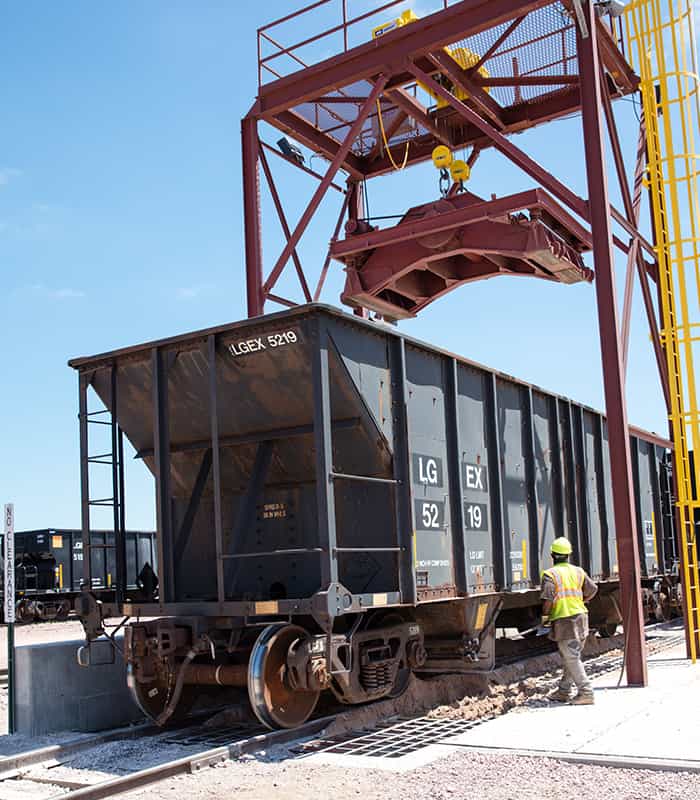
managing growth
The Sioux City transloading facility is serviced by the D & I (Dakota & Iowa) Railroad, which is a wholly-owned subsidiary of L.G. Everist. The D & I rail service operates from Dell Rapids, South Dakota, (home of the company’s largest facility) to the Sioux City, Iowa site.
“When the rail system was developed in the early 1980s, it was a new-found freedom,” says Sioux City Plant Superintendent Mark Bowden, an industry veteran who started with the company in 1979. “At that time, if we could unload 20 railcars per day and stockpile only eight or so different products, that was a big day for us,” he adds.
Over the decades, the operation grew to unloading 60- to 80-railcars per day. With its older, smaller unloading system, the operation could unload a maximum of 5- to 6-cars per hour – or about 500 tons per hour into its single hopper system. “In the past, a 60-car train would take us more than 12 hours to unload, and then we had maintenance to do as well,” says Bowden.
With the new system, Bowden says that the crew can unload a 100-car train in less than ten hours, which almost doubles past capacities; and allow for maintenance after the shift. From an approximate 30 stockpiles, the operation loads out anywhere from 4,000 to 10,000 tons of aggregate onto trucks; or 300- to 500-truckloads per day.
System Design
Bowden explains that the operation utilizes pneumatic railcars, each with three doors. Within the yard, the locomotive is operated remotely from a mobile controller box to advance the train as needed. One by one, railcars are unloaded over an under-track, three hopper system. With the push of a button, the three railcar doors open, and material from each bin unloads onto three inclined (36-inch belt) conveyors. “To adjust to changing materials, we can vary the speed of the conveyors coming out of the hoppers, or adjust the gates to affect material flow – opening them up more for denser materials or shutting them down a bit for lighter materials to avoid overflow,” he explains.
From the inclined conveyors, material is conveyed to a transverse (48-inch belt) conveyor which transports material either to the east or west depending upon the product type. Portable jump conveyors transfer material to the telescoping radial stacking conveyors. The jump conveyors allow flexibility as units can be easily added or extracted depending upon the ever-changing volume levels of the stockpiles. “We can pull out, put in, or move the conveyors very quickly. Where it used to take us from one to two hours to adjust between products – now it takes us mere minutes. It saves us so much time,” says Bowden.
As the telescoping radial stacking conveyors provide increased stacking capacity over standard radial stackers, the operation can stockpile up to 30-percent more material under each stacker. Bowden says that’s important within their limited footprint. Even more important is the benefit that TeleStacker® Conveyors allow them to avoid costly material segregation by stockpiling in very thin lifts or layers, with each layer consisting of a series of windrows of material. “In our business, segregation and material degradation is an issue you have to overcome, and with these conveyors, we can eliminate that completely,” he says.
As to maintenance issues thus far, Bowden says it’s minimal. “The system is heavy-duty, and reacts well to abrasive material. Its design is pretty straightforward with all components being standardized, so that we don’t have to inventory a lot of different parts. The conveyors are also equipped with belt cleaners and scrapers, so that we can protect our belts – and keep our pit clean.”
moving forward
More than 35,000 railcars serve the U.S. aggregate industry; and efficient transloading facilities are a key factor in cost-effective material transport. Automated and integrated unloading, loading, and stockpiling systems continue to streamline operations at railcar facilities, as well as at barge and marine distribution centers worldwide.
Have questions? Need more information? Complete the form below and we will follow up shortly.
Request More Info
See our privacy policy.

